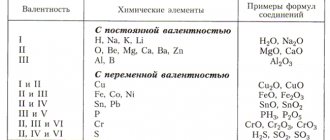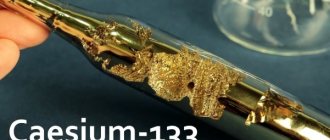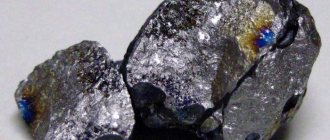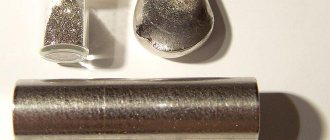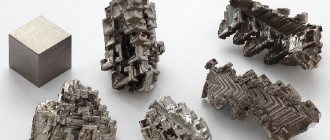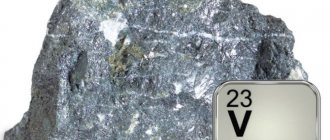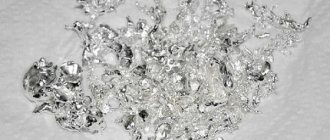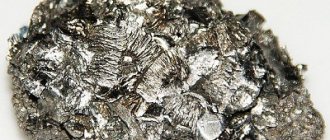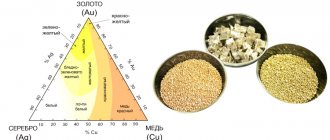| 11 | Sodium |
| Na 22,9898 | |
| [Ne]3s1 | |
Sodium
(
Na
, lat. natrium) is a chemical element of the first group, the third period of the periodic system of Mendeleev, with atomic number 11. As a simple substance, it is a soft alkali metal of a silvery-white color. At the outer energy level, sodium has one electron, which it easily gives up, turning into the positively charged Na+ cation. The only stable isotope is 23Na. It is not found in free form, but can be obtained from various compounds. Sodium is the sixth most abundant element in the earth's crust and is found in numerous minerals, including feldspars, sodalite, and "rock salt" (halite, sodium chloride).
History and origin of the name
Sodium compounds have been known and used since ancient times. The ancient Greek translation of the Bible - the Septuagint - mentions the word νίτρον (in the Latin translation - Vulgate - it corresponds to the word nitroet) as the name of a substance like soda or potash, which, when mixed with oil, served as a detergent (Jer. 2:22). In the Tanakh the word νίτρον corresponds to ancient Hebrew. ברית - “soap” and נתר - “lye” (soapy liquid). Soda (natron) occurs naturally in the waters of soda lakes in Egypt. The ancient Egyptians used natural soda for embalming, bleaching canvas, cooking food, and making paints and glazes. Pliny the Elder writes that in the Nile Delta, soda (it contained a sufficient proportion of impurities) was isolated from river water. It went on sale in the form of large pieces, colored gray or even black due to the admixture of coal.
The name "sodium" comes from the Latin word natrium
(cf. Ancient Greek νίτρον), which was borrowed from the Middle Egyptian language (
nṯr
), where it meant, among other things: “soda”, “caustic soda”.
Abbreviation "Na" and the word natrium
were first used by academician, founder of the Swedish Society of Physicians, Jöns Jakob Berzelius (1779-1848) to refer to natural mineral salts, which included soda.
Previously (and also still in English, French and a number of other languages), the element was called sodium
(Latin sodium) - this name
sodium
may go back to the Arabic word
suda
, meaning “headache”, since soda was used at that time as a headache medicine.
Metallic sodium was first obtained by the English chemist Humphry Davy by electrolysis of molten sodium hydroxide. Davy reported this on November 19, 1807, in the Baker Lecture (in the manuscript of the lecture, Davy indicated that he discovered potassium on October 6, 1807, and sodium a few days after potassium).
From the Bible to the present day
The story of the hero of the article stretches back to biblical times. It was in the Bible that a substance was mentioned that was used to wash and bleach cotton fabrics. Translated, the word νίτρον (nitron) means soap or lye.
Freshly cut sodium
For many centuries, people have used natural soda or lye from ash for household needs.
The metal sodium was first obtained by H. Davy from NaOH.
Receipt
Industrial production of sodium using the Deville method, common in the 19th century. AC
- iron tube with a mixture of soda, coal and chalk;
B
- Donny and Maresca refrigerator;
R
- receiver with oil
The first industrial method of producing sodium was the reduction reaction of sodium carbonate with coal by heating a close mixture of these substances in an iron container to 1000 °C (Deville’s method):
Na2CO3 + 2C →1000oC 2Na + 3CO
Instead of coal, calcium carbide, aluminum, silicon, ferrosilicon, and silicoaluminum can be used.
With the advent of electric power, another method of producing sodium became more practical - electrolysis of molten sodium hydroxide or sodium chloride:
4NaOH →electric current 4Na + 2H2O + O2, 2NaCl →electric current 2Na + Cl2.
Currently, electrolysis is the main method for producing sodium.
Sodium can also be obtained by the zirconium thermal method or by thermal decomposition of sodium azide.
Forms of being in nature
The substance is not found in nature in its free form, only minerals or compounds.
The most famous minerals: sodalite, halite (“rock salt”), feldspars.
A ton of the earth's crust contains on average 25 kg of sodium, a liter of sea and ocean water contains 10.5 g of substance compounds.
Physical properties
Sodium metal retained in mineral oil
Qualitative determination of sodium using a flame - bright yellow color of the emission spectrum “sodium D-line”, doublet 588.9950 and 589.5924 nm
Sodium is a silvery-white metal, in thin layers with a violet tint, plastic, even soft (easily cut knife), the fresh cut of sodium shines. The electrical and thermal conductivity values of sodium are quite high, the density is 0.96842 g/cm³ (at 19.7 °C), the melting point is 97.86 °C, and the boiling point is 883.15 °C.
Under high pressure it becomes transparent and red, like a ruby.
At room temperature, sodium forms cubic crystals, space group I m
3
m
, cell parameters
a
= 0.42820 nm,
Z
= 2.
At a temperature of −268 °C (5 K), sodium transforms into the hexagonal phase, space group P
63/
mmc
, cell parameters
a
= 0.3767 nm,
c
= 0.6154 nm,
Z
= 2.
Minerals, deposits
Minerals found in nature:
- mirabilite (Glauber's salt);
- halite (rock salt);
- borax (formula Na2B4O7 • 10H2O);
- cryolite.
There are no deposits of metallic sodium on the planet. In any place (even in deserts) there is water with which the metal will instantly react.
Chemical properties
An alkali metal easily oxidizes to sodium oxide in air. To protect against atmospheric oxygen, sodium metal is stored under a layer of kerosene.
4Na + O2 → 2Na2O
When burned in air or oxygen, sodium peroxide is formed:
2Na + O2 →to Na2O2
In addition, there is sodium ozonide NaO3.
Sodium reacts very violently with water; a piece of sodium placed in water floats up, due to the heat generated, it melts, turning into a white ball that quickly moves in different directions along the surface of the water; the reaction occurs with the release of hydrogen, which can ignite. Reaction equation:
2Na + 2H2O → 2NaOH + H2↑
Like all alkali metals, sodium is a strong reducing agent and reacts vigorously with many non-metals (with the exception of nitrogen, iodine, carbon, noble gases):
2Na + Cl2 → 2NaCl 2Na + H2 →250−400oC,p 2NaH
Sodium is more active than lithium. It reacts extremely poorly with nitrogen in a glow discharge, forming a very unstable substance - sodium nitride (as opposed to the easily formed lithium nitride):
6Na + N2 → 2Na3N
It reacts with dilute acids like an ordinary metal:
2Na + 2HCl → 2NaCl + H2↑
With concentrated oxidizing acids, reduction products are released:
8Na + 10HNO3 → 8NaNO3 + NH4NO3 + 3H2O
Dissolves in liquid ammonia, forming a blue solution:
Na + 4NH3 →−40oC Na[NH3]4
Reacts with ammonia gas when heated:
2Na + 2NH3 →350oC 2NaNH2 + H2
With mercury it forms sodium amalgam, which is used as a softer reducing agent instead of pure metal. When fused with potassium it produces a liquid alloy.
Alkyl halides with excess metal can produce organosodium compounds, highly reactive compounds that usually spontaneously ignite in air and explode with water. When there is a lack of metal, the Wurtz reaction occurs.
Reacts with alcohols, phenols, carboxylic acids to form salts.
It dissolves in crown ethers in the presence of organic solvents, giving an electride or alkalide (in the latter, sodium has an unusual oxidation state of −1).
Application
Sodium metal is widely used as a strong reducing agent in preparative chemistry and industry, including metallurgy. Used for drying organic solvents such as ether. Sodium is used in the production of highly energy-intensive sodium-sulfur batteries. It is also used in exhaust valves of truck engines as a liquid heat sink. Occasionally, sodium metal is used as a material for electrical wires intended to carry very high currents.
In an alloy with potassium, as well as with rubidium and cesium, it is used as a highly efficient coolant. In particular, the alloy of composition sodium 12%, potassium 47%, cesium 41% has a record low melting point of −78 °C and was proposed as a working fluid for ion rocket engines and a coolant for nuclear power plants.
Liquid metal coolant in fast neutron nuclear reactors BN-600 and BN-800.
Sodium is also used in high and low pressure discharge lamps (HPLD and LPLD). NLVD lamps of the DNaT (Arc Sodium Tubular) type are very widely used in street lighting. They give off a bright yellow light. The service life of HPS lamps is 12-24 thousand hours. Therefore, gas-discharge lamps of the HPS type are indispensable for urban, architectural and industrial lighting. There are also lamps DNaS, DNaMT (Arc Sodium Matte), DNaZ (Arc Sodium Mirror) and DNaTBR (Arc Sodium Tubular Without Mercury).
Sodium metal is used in the qualitative analysis of organic matter. The alloy of sodium and the test substance is neutralized with ethanol, a few milliliters of distilled water are added and divided into 3 parts; the J. Lassaigne test (1843) is aimed at determining nitrogen, sulfur and halogens (Beilstein test).
Sodium chloride (NaCl) (table salt) is the oldest used flavoring and preservative.
Sodium azide (NaN3) is used as a nitriding agent in metallurgy and in the production of lead azide.
Sodium cyanide (NaCN) is used in the hydrometallurgical method of leaching gold from rocks, as well as in the nitrocarburization of steel and in electroplating (silvering, gilding).
Sodium chlorate (NaClO3) is used to destroy unwanted vegetation on railway tracks.
Sodium isotopes
Main article: Isotopes of sodium
Currently (2012) 20 isotopes with mass numbers from 18 to 37 and 2 nuclear isomers of sodium are known. The only stable isotope is 23Na. Most isotopes have a half-life of less than one minute; only one radioactive isotope, 22Na, has a half-life of more than a year. 22Na undergoes positron decay with a half-life of 2.6027 years and is used as a positron source and in scientific research. 24Na, with a β− decay half-life of 15 hours, is used in medicine for the diagnosis and treatment of some forms of leukemia.
What is
Sodium is element No. 11 of Dmitri Mendeleev’s periodic table.
A soft, silvery-white substance that belongs to the alkaline group of metals.
The structure of the crystal lattice of the substance is cubic.
The composition of the substance consists of two dozen isotopes, of which only one is stable. Most do not “live” longer than a minute; the “long-liver” is the radioactive isotope Na-22 (more than a year).
Official designation of the substance: Na, Natrium.
Biological role
Sodium is part of all living organisms. In higher organisms, sodium is found mostly in the intercellular fluid of cells (about 15 times more than in the cytoplasm of the cell). The concentration difference maintains the sodium-potassium pump built into the cell membrane, pumping sodium ions from the cytoplasm into the intercellular fluid.
Together with potassium, sodium performs the following functions:
- Creating conditions for the occurrence of membrane potential and muscle contractions.
- Maintaining blood osmotic concentration.
- Maintaining acid-base balance.
- Normalization of water balance.
- Ensuring membrane transport.
- Activation of many enzymes.
The recommended sodium intake for children is 600 to 1,700 milligrams. For adults, according to the American Heart Association, the minimum required dose is less than 500 milligrams, with a recommendation of up to 1,500 milligrams per day (except for some illnesses or occupations that require higher amounts of sodium). As table salt, 3/4 teaspoon contains 1,725 milligrams of sodium. According to other data, healthy adults should limit their sodium intake to 2,300 milligrams, and people with high blood pressure and a number of other diseases should limit their sodium intake to 1,500 or less.
Sodium is found in almost all products in varying quantities, although the body receives most of it from table salt, including in canned food, semi-finished products, sauces, sausages, etc. Other dietary sources of sodium include monosodium glutamate, baking soda (sodium bicarbonate), sodium nitrite, sodium saccharinate, and sodium benzoate. Absorption mainly occurs in the stomach and small intestine. Vitamin D improves sodium absorption, but excessively salty foods and foods rich in protein interfere with normal absorption. The amount of sodium taken in from food shows the sodium content in the urine. Sodium-rich foods are characterized by accelerated excretion.
Sodium deficiency does not occur in a person who eats a balanced diet, but some problems can arise during fasting. Temporary deficiency may be caused by the use of diuretics, diarrhea, excessive sweating, or excess water intake.
Symptoms of sodium deficiency include weight loss, vomiting, gas formation in the gastrointestinal tract, and impaired absorption of amino acids and monosaccharides. Long-term deficiency causes muscle cramps and neuralgia.
Too much sodium causes swelling of the legs and face, increased potassium excretion in the urine, and in some people, high blood pressure and fluid retention. The maximum amount of salt that can be processed by the kidneys is approximately 20-30 grams; any larger amount is life-threatening.
